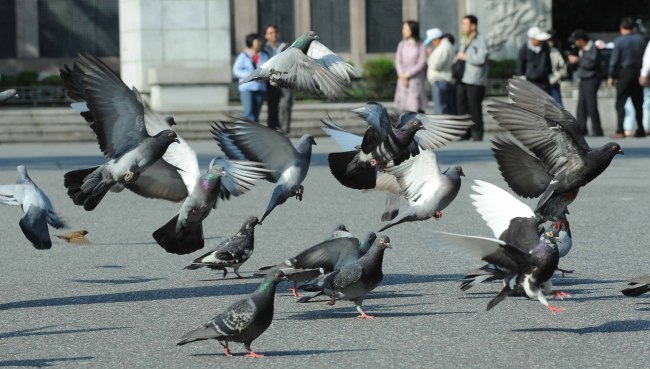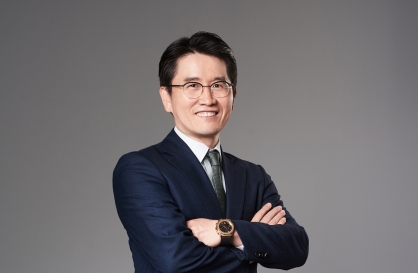Korea grapples with health risks, damage from city pigeons
By Suk Gee-hyunPublished : Dec. 2, 2013 - 20:07

Throughout history, pigeons and doves have been symbols of love and peace and used as messengers over long distances.
The birds have now turned into an urban headache posing health risks, damaging property and spoiling the landscape. They are often branded as “flying rats” and “chickgeons” (referring to overweight birds).
The Ministry of Environment designated city pigeons as harmful wildlife in 2009 for carrying pathogenic disease germs and defacing buildings and cultural assets with excreta.
But the authorities are still fighting an uphill battle to control the species, which is extraordinarily good at surviving and adapting.
Experts criticize the government for failing to take specific measures, even an updated survey, though increasing damage has occurred in the city due to their droppings, noise, flying feathers and their mere presence.
“Managing pigeons effectively is a must for citizens’ health, but there’s a lack of studies done on this issue,” said a bird researcher who wished to be identified by his last name, Kim.
“The government had made it a big thing about pigeons being harmful animals, but has done nothing to prove why they’re harmful and why people should be aware,” the scholar said.
The ministry has no data or records on the birds, other than a report they submitted for the designation four years ago.
“We have not tracked down the number of pigeons nor done follow-up measures since designating them as harmful animals in 2009,” Jung Seung-hwa, an official in charge of the issue at the ministry, told The Korea Herald.
According to the ministry’s 2009 data, there are 35,575 pigeons scavenging the streets for food and defecating on buildings in Seoul. Considering that they lay more than two eggs at once and they take 18 to 19 days to hatch, the population continues to increase.
About 35 percent of them congregate in parks, 19 percent around bridges, 16 percent in residential areas and 15 percent of them in downtown buildings.
“We receive the most calls from office buildings, for corrosion of building ledges or pigeon sounds bothering them,” says Hwang Chang-yong, who sells bird spikes and other repellants for birds.
“City pigeons are a highly invasive and adaptive species, and we always have to come up with new ways other than using sprays or bird spikes, to shoo them away or capture them.”
Since the 1960s, the government has actively brought them into the country to celebrate major events like the 1988 Olympics. The government built bird nests near the Han River for pigeons so it could release thousands of them for national events.
The most obvious problem associated with city pigeons are their droppings having a corrosive effect on buildings, automobiles, railways and even cultural assets.
In 1999, the Korean government had to inject some one billion won to put a glass box over a 10-story pagoda in Tapgol Park in Jongno, Seoul, one of the areas with the highest pigeon population.
The health threats are substantial as well, with their droppings known to spread over 60 transmittable diseases to humans and animals. According to a study by a disease center in Atlanta, Georgia, pigeon droppings can cause diseases that affect the brain, lungs, skin and digestive tract. They can also contaminate food and water and release airborne spores that can be inhaled.
Both the ministry and bird experts say long-term reduction of city pigeon populations can be done by restricting the food supply.
The same method is being used in Trafalgar Square in London. In 2003, then-London Mayor Ken Livingstone banned the feeding of pigeons after 140,000 pounds (232 million won) in damage occurred in the area. People found feeding the birds were faced with a 50 pound (86,000 won) fine and possible prosecution. But due to civic groups’ backlash, the by-law was eased to allowing feeding pigeons only once a day.
“Such a measure should be used in Korea as well, if the Environment Ministry truly believes they’re harmful to the city and people,” Kim noted.
By Suk Gee-hyun (monicasuk@heraldcorp.com)
The birds have now turned into an urban headache posing health risks, damaging property and spoiling the landscape. They are often branded as “flying rats” and “chickgeons” (referring to overweight birds).
The Ministry of Environment designated city pigeons as harmful wildlife in 2009 for carrying pathogenic disease germs and defacing buildings and cultural assets with excreta.
But the authorities are still fighting an uphill battle to control the species, which is extraordinarily good at surviving and adapting.
Experts criticize the government for failing to take specific measures, even an updated survey, though increasing damage has occurred in the city due to their droppings, noise, flying feathers and their mere presence.
“Managing pigeons effectively is a must for citizens’ health, but there’s a lack of studies done on this issue,” said a bird researcher who wished to be identified by his last name, Kim.
“The government had made it a big thing about pigeons being harmful animals, but has done nothing to prove why they’re harmful and why people should be aware,” the scholar said.
The ministry has no data or records on the birds, other than a report they submitted for the designation four years ago.
“We have not tracked down the number of pigeons nor done follow-up measures since designating them as harmful animals in 2009,” Jung Seung-hwa, an official in charge of the issue at the ministry, told The Korea Herald.
According to the ministry’s 2009 data, there are 35,575 pigeons scavenging the streets for food and defecating on buildings in Seoul. Considering that they lay more than two eggs at once and they take 18 to 19 days to hatch, the population continues to increase.
About 35 percent of them congregate in parks, 19 percent around bridges, 16 percent in residential areas and 15 percent of them in downtown buildings.
“We receive the most calls from office buildings, for corrosion of building ledges or pigeon sounds bothering them,” says Hwang Chang-yong, who sells bird spikes and other repellants for birds.
“City pigeons are a highly invasive and adaptive species, and we always have to come up with new ways other than using sprays or bird spikes, to shoo them away or capture them.”
Since the 1960s, the government has actively brought them into the country to celebrate major events like the 1988 Olympics. The government built bird nests near the Han River for pigeons so it could release thousands of them for national events.
The most obvious problem associated with city pigeons are their droppings having a corrosive effect on buildings, automobiles, railways and even cultural assets.
In 1999, the Korean government had to inject some one billion won to put a glass box over a 10-story pagoda in Tapgol Park in Jongno, Seoul, one of the areas with the highest pigeon population.
The health threats are substantial as well, with their droppings known to spread over 60 transmittable diseases to humans and animals. According to a study by a disease center in Atlanta, Georgia, pigeon droppings can cause diseases that affect the brain, lungs, skin and digestive tract. They can also contaminate food and water and release airborne spores that can be inhaled.
Both the ministry and bird experts say long-term reduction of city pigeon populations can be done by restricting the food supply.
The same method is being used in Trafalgar Square in London. In 2003, then-London Mayor Ken Livingstone banned the feeding of pigeons after 140,000 pounds (232 million won) in damage occurred in the area. People found feeding the birds were faced with a 50 pound (86,000 won) fine and possible prosecution. But due to civic groups’ backlash, the by-law was eased to allowing feeding pigeons only once a day.
“Such a measure should be used in Korea as well, if the Environment Ministry truly believes they’re harmful to the city and people,” Kim noted.
By Suk Gee-hyun (monicasuk@heraldcorp.com)






![[Weekender] How DDP emerged as an icon of Seoul](http://res.heraldm.com/phpwas/restmb_idxmake.php?idx=644&simg=/content/image/2024/04/25/20240425050915_0.jpg&u=)


![[Music in drama] An ode to childhood trauma](http://res.heraldm.com/phpwas/restmb_idxmake.php?idx=644&simg=/content/image/2024/04/25/20240425050929_0.jpg&u=)








![[Herald Interview] Mistakes turn into blessings in street performance, director says](http://res.heraldm.com/phpwas/restmb_idxmake.php?idx=652&simg=/content/image/2024/04/28/20240428050150_0.jpg&u=20240428174656)
